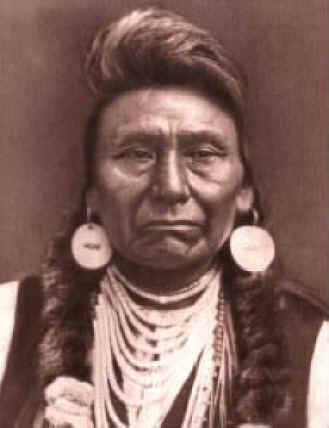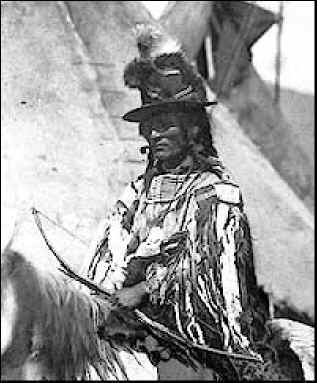|

|
|
| The Nez Perce were given their
names by the French because some of the Nez Perce wore nose pendents.
After the introduction of horses the Nez Perce were then noted after that
to be horse breeders and this made buffalo hunting easier. In 1805
the Nez Perce were visited by Lewis an Clark. In 1830 they
sent leaders and chiefs to St. Louis to ask for books and teachers.
In 1855 they gave away a large part of their land to the United States. |
|
| The War of 1877 was the non-treaty
Nez Perce against U.S. troops. In 1877 most of the Nez Perce were
living on reservations, but some of them refused to move. The leader
of one Nez Perce tribe was Chief Joseph. Chief Joseph inherited the
leadership because his father died and Joseph was elected new
leader. In 1877 Chief Joseph led, one of the most brilliant retreats
in Indian history with it scanning over 1,500 miles. The Nez Perce
won many battles along the way only fighting troops if they came to close
or were engaged. Joseph refused to leave the Wallowa Valley, given
to the U.S. by the Treaty of 1863, because Joseph and the Nez Perce never
signed it. General Oliver Howard was ordered to remove the Nez Perce.
Joseph was finally going to agree and start to move his people to the
reservation, but before they could leave a band of his own Indians slipped
away and killed eighteen settlers. Howard was furious and sent
Captain David Perry to bring in all of the Nez Perce. At Whitebird
Canyon Perry attacked, but the Nez Perce were ready and drove them back,
thirty-three soldiers died at Whitbird Canyon, but only three Nez Perce
warriors died. After the battle, the indians did nothing to the
dead. |

Chief Joseph (1804-1904) |
|
| After Whitebird Joseph took his
people on a three month retreat toward Canada. On July 3rd they
killed a scouting party of thirteen soldiers. On July 4th at an
abandon stage stop called Cotton Wood they fought off another
attack. On July 11th they killed thirteen more of Howard's men at
the Clearwater River. In the Clearwater battle Looking Glass joined
the Nez Perce and strengthened their warriors greatly. Afterwards
they had to climb the Bitterroot Mountains. At this time Looking
Glass led them. They were following the trail that had led Lewis and
Clark to them just must more than seven centuries earlier. There
were about seven-hundred people but only two-hundred of those were
warriors the rest were women and children. Even though they had all
these women and children they moved fast. They were hoping that if
they made it to Montana they could join there allies the Crow. When
they finally made it to Montana they turned south following the Bitterroot
River. Sometimes they would stop in towns so they could get
supplies. Some of the towns were scared and asked for army
protection. |
|
|

Looking Glass (1832-1877) |
At Big Hole Looking Glass convinced
the elders they could rest for many days, because he thought Howard was
many days back, but what Looking Glass didn't know was that Colonel John
Gibbons had mustered a small army of troops and had tracked the Nez Perce
to Big Hole. At dawn on August 9th at Big Hole Colonel Gibbons
attacked and at first ninety Nez Perce died, mostly women and children,
but the remaining Nez Perce and warriors regrouped and drove the remaining
soldiers out of the camp. The warriors trapped Gibbons and his men
while Joseph led the rest to safety. After Big Hole the Nez Perce
went back to Idaho then east to the Yellowstone Plateau The Nez
Perce captured more than a dozen settlers and murdered two before they let
the rest go. They still went seeking the Crow, but what they didn't
know was that the Crow were chasing them on behalf of the military. |
| |
| After they found out that the Crow
had betrayed them they headed north to try and join Sitting Bull. On
August 20th at Camas Meadows they stole one-hundred-fifty mules and slowed
Howards march. On September 13th at Canyon Creek they fought off an
attack by Colonel Sturgis. The Nez Perce had crossed many rivers and
finally they crossed there final the Missouri. They had come more
than 1,500 miles, fought in more than seventeen engagements, and had
fought more than two-thousand Indian scouts and soldiers. They had
suffered many losses and hardships. They had beaten or avoided every
army set against them. Now they were only miles away from freedom. |
|
| At Bear Paw only forty miles away
from Canada they took a final break before their final journey to
freedom. They knew that Howard was more than two days march back,
but who they didn't know about was Colonel Nelson A. Miles. Miles had
pushed his unit through Montana to intercept the Nez Perce. Also
fighting with Mile's army were Cheyenne and Lakota warriors. The
Bear Paw battle was the last battle for both sides. The soldiers
charged at dawn but the Indians were ready and drove back the first, the
second, and the third attack. The Nez Perce killed or wounded
fifty-three soldiers but all of there horses had been driven off and they
couldn't escape. The weather turned cold an Miles dug in for a siege.
Some of the Indians slipped behind the lines and made their way into
Canada. Sitting Bull welcomed them warmly but would send no
help. Miles opened negotiations and said if they turned over their
rifles that in the Spring they could return to the Wallowa Valley.
The people were divided about surrendering but Jospeh couldn't bare to see
his people suffer. He also believed Miles about
returning to their homeland. On October 5, 1877, Chief Joespeh or
the "Red Nepolean" ,as he was known to the whites, rode out on
his horse, got off, and handed over his rifle to Miles in token of
surrender. Chief Joseph gave one of the most eloquent surrender
speeches ever. |
| |
| "I am tired of
fighting. Our chiefs are all killed. Looking Glass is
dead... The old men are all dead. It is cold, and we have no
blankets. The little children are freezing to death. My
people, some of them, have run away to the hills, and have no food.
No one knows where they are... I want to have time to look for my
children and see how many of them I can find. Maybe I shall
find them among the dead. Hear me my chiefs! I am tired.
My heart is sick and sad. From where the sun now stands I will fight
no more forever." |
| |
| On the same day as
Joseph's surrender Looking Glass rode out to join Sitting Bull, but before
he made it to Canada he was killed by a Cheyenne scout. The rest of
Joseph and his people were sent off to Fort Abraham Lincoln in Dakota
Territory where they thought they would stay the winter, but on the way
the promise that Miles had made about them returning to their homeland was
overruled by General William Tecumseh Sherman. when the Nez Perce
arrived at the fort they were loaded onto a train. On the train they
were told that they weren't returning to their homeland in Oregon, but to
exhile in Indian Territory. Chief Joseph and the Nez Perce were once
again betrayed. In this new territory conditions were unlivable and supplies
were scarce. Sixty-eight Indians died in the first year alone.
Not long after they had a cemetery set aside just for babies with a
hundred graves. Joseph died in 1904, but still twenty-seven years
after the War of 1877 Joseph died with a "broken heart." |
| |
"You might as well expect the rivers to run backwards
as that any man who was born a freeman should be contented when
penned up and denied liberty to go where he pleases..."
Chief Joseph
|
|
|
|
Ryan Kerwin
8th American History
Rossville Jr. High
Plains History Project
2004
|
Bibliography
|


